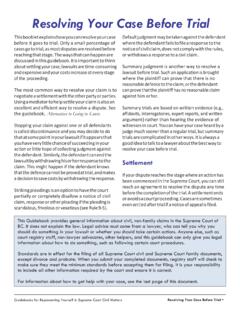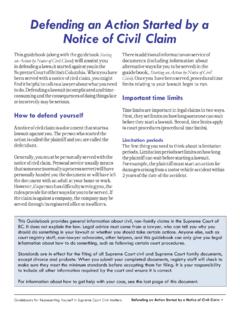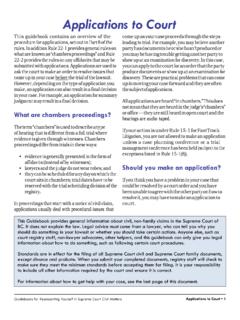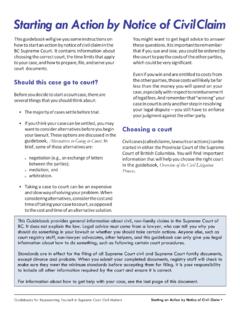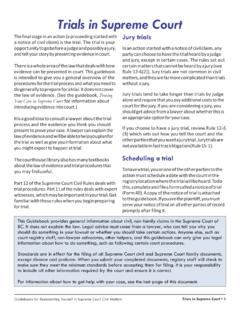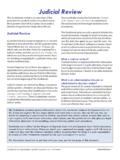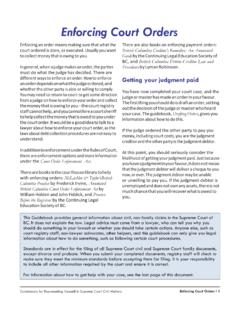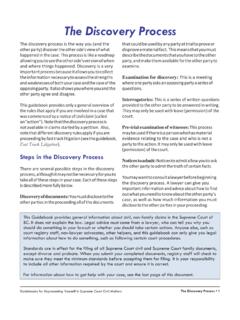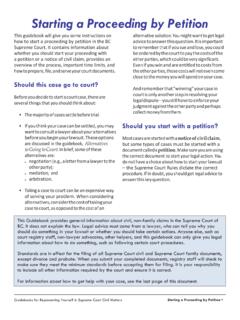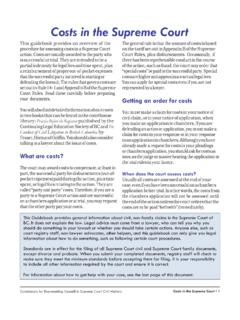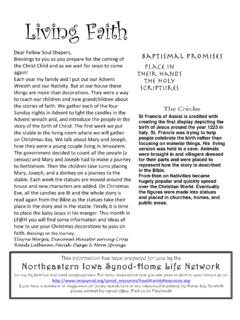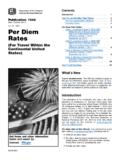Transcription of A Guide to Preparing Your Affidavit - …
1 A Guide to Preparing Your Affidavit Guidebooks for Representing Yourself in Supreme Court Civil Matters A Guide to Preparing Your Affidavit This Guidebook describes the steps you take to prepare your Affidavit . We use affidavits to present evidence to the court. Sometimes, courts hear evidence from witnesses who give their evidence in person, orally. However, for evidence without a witness like receipts, photographs, or personal accounts of facts in the case you must present your evidence by affidavits. What is an Affidavit ? An Affidavit is a written statement that contains important facts you want the judge or the master to know about. You swear it under an oath (or affirm) before a registry clerk or a lawyer.
2 To swear means you promise that the information contained in the Affidavit is true. In the Supreme Court of BC, there is a form you must fill out for your Affidavit . It is called Form 109. See Resource D: Sample Affidavit and Resource E: Sample Completed Affidavit The Affidavit may have letters or other important documents attached to it. These are often referred to as exhibits to the Affidavit . The Affidavit is filed in the court registry. Copies of the Affidavit have to be given to the other persons named in the lawsuit. The first rule about Preparing an Affidavit is that you should tell the truth in your Affidavit . This Guidebook provides general information about civil, non-family claims in the Supreme Court of BC.
3 It does not explain the law. Legal advice must come from a lawyer, who can tell you why you should do something in your lawsuit or whether you should take certain actions. Anyone else, such as court registry staff, non-lawyer advocates, other helpers, and this guidebook can only give you legal information about how to do something, such as following certain court procedures. Standards are in effect for the filing of all Supreme Court civil and Supreme Court family documents, except divorce and probate. When you submit your completed documents, registry staff will check to make sure they meet the minimum standards before accepting them for filing. It is your responsibility to include all other information required by the court and ensure it is correct.
4 For information about how to get help with your case, see the last page of this document. Express Lane If you are pressed for time, use the express lane. Here s what you do: Read the second, third and fourth sections of this Guidebook. Make an appointment with a lawyer see Resource A. Take this Guide with you when you go. Ask the lawyer what you need to put in the Affidavit see Resource B. Ask the lawyer to fill out the front page of the sample Affidavit see Resource D. Follow section 3 to make sure the technical pieces are filled out. Follow section 4 to fill out the body of Affidavit . Take the completed Affidavit back to a lawyer. The lawyer should read it over and have it sworn for you.
5 A Guide to Preparing Your Affidavit Guidebooks for Representing Yourself in Supreme Court Civil Matters What s in this Guidebook? This Guidebook has five sections: 1. Get a general idea of what you put in affidavits 2. Review the structure of an Affidavit 3. Find out how to fill in the technical parts 4. Find out how to fill out the main part 5. Resources o Where to get legal advice o Questions to ask the lawyer o Checklist o Sample Affidavit o Sample of a completed Affidavit If you re doing it yourself, get some legal advice If you are going to represent yourself, get some advice from a lawyer. Do this before you start. Look at Resource A to find out where to get free legal advice if you re on a low income.
6 Look at Resource B for questions you can take to a lawyer. A lawyer can tell you what special information about your case you should include in your Affidavit . There are two important things to remember about affidavits: what you put in must be relevant, and it must be fact, not opinion. What you put in your Affidavit must be relevant to your case The statement you make in the Affidavit and documents attached to the Affidavit must be relevant to the matter before the court. This is the key to having a good Affidavit . What are the important facts that have to be put in the Affidavit ? A lawyer can answer that question. The preparation of the Affidavit must be done in the context of the whole case.
7 What are your strategies for the court case? Your Affidavit should be drafted in that context. Again, get legal advice. Your Affidavit sets out facts, not opinions Affidavits contain facts, not opinions. Fact: You saw something happen and you have personal knowledge of it. Example: I saw Tom Smith hit Harry Jones on the nose on February 7, 2009 at 3:00 This occurred outside the home of Harry Jones at 123 Main Street, Vancouver, BC. Opinion: What you think or believe: Example: I think Tom Smith is a bad person. Sometimes, opinions are important. For instance, doctors and other experts can give their opinion in court. However, lay people present facts in an Affidavit , not opinions.
8 Get a general idea of what goes in affidavits Look at Resource D: Sample Affidavit and Resource E: Sample Completed Affidavit in the Resources section of this Guidebook. An Affidavit has seven parts. We will look at each them in turn. 1. Style of proceeding 2. Deponent s statement ( deponent is the person making the Affidavit ) 3. Knowledge statement 4. Body of the Affidavit (this is the most important part of the Affidavit ) 5. Ending of the Affidavit 6. Exhibits 7. Backing sheet Most parts of the Affidavit are technical. Section 3 explains how to fill them out. The body of the Affidavit is where you explain your story to the judge. Follow the steps in section 4 to fill it out correctly.
9 Important: Read both section 3 and section 4 before you start work on your Affidavit . A Guide to Preparing Your Affidavit Guidebooks for Representing Yourself in Supreme Court Civil Matters Review the structure of an Affidavit As you go through each part of this section, look at the sample Affidavit and the sample completed Affidavit . They are located in the Resources section of this Guidebook. 1. Style of Proceeding A style of proceeding appears on the first page of all court documents. It states who is suing whom and also gives the file number and court registry name. See sample Affidavit and the sample completed Affidavit . The style of proceeding remains unchanged throughout the life of the court case unless the judge orders otherwise.
10 The style of proceeding enables the court registry staff to put the document in the right court file. There are three things you have to do. In the top right hand corner of the style of proceeding you must write: the number of the Affidavit (you may have made more than one) your name (you are the deponent); the date on which you made the Affidavit . Example: This is the 3rd Affidavit of Mary Smith in this case and was made on 01/06/2010 This goes in the right-hand corner so the judge can easily identify the Affidavit . The number 3 indicates it is the third Affidavit sworn by Mary Smith. You need to swear the Affidavit . This means you swear under oath (to God) OR you affirm that you are telling the truth in the Affidavit .
